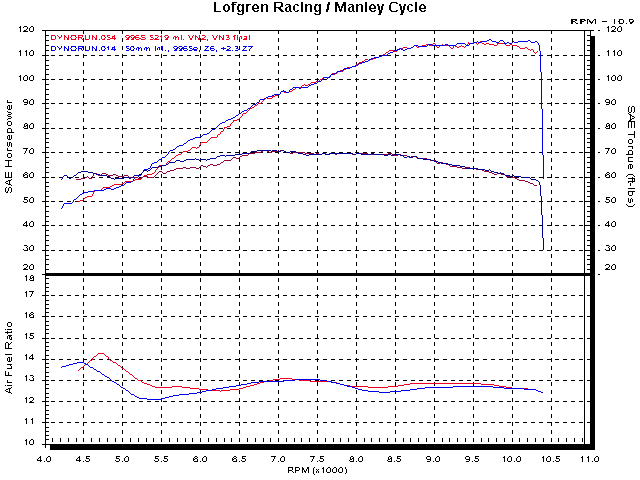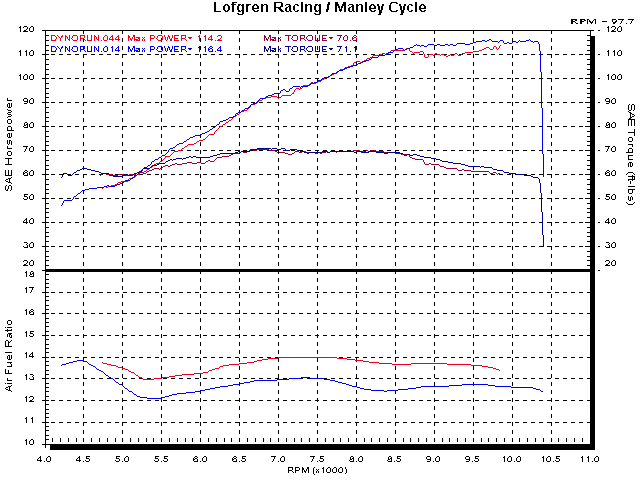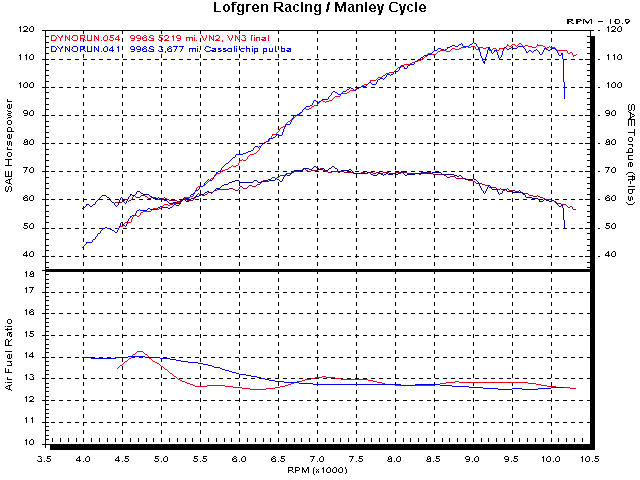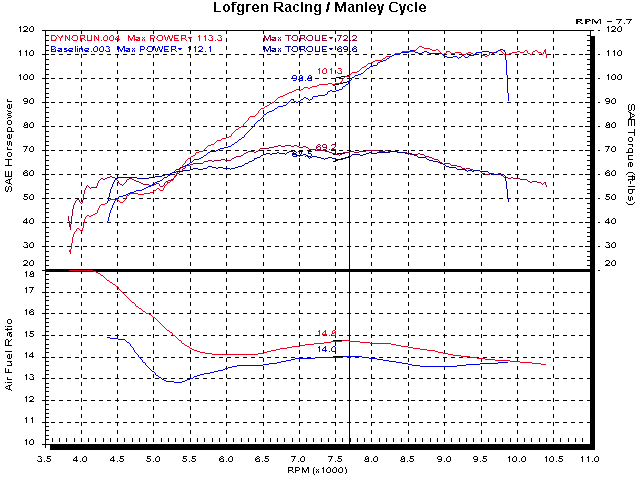
Air/fuel Ratio Variations in the Ducati 996
For an excellent education in the operation of fuel injection, you should got to the Sigma Performance site. Neil Spaulding with the help of Duane Mitchell has written 'the' article on the Weber-Marelli system used on Ducatis. Sigma/weber.html and/or Sigma/weber-ultimap.html
Also, the FIM site Fuel Injected Motorcycles
Are you done reading all of that? OK!
Then you know that there are several sensors that are used to adjust the fuel flow, besides the main fuel map. They are;
Coolant temperature sensor
Air temperature sensor
Barometric pressure sensor
Plus, the two critical devices, which directly control fuel flow.
Injector flow rate
Fuel pressure
Shifts in the calibration of the sensors can cause a shift in fuel rate due to the information they give to the ECU and the correction values written into the tables on the chip.
Injector flow rate has a direct influence on the fuel flow. The intention is that the injectors are within a couple percent of one another, but I've seen a little more than that on our injector flow bench.
Fuel pressure variations change the fuel flow as the square root of the pressure difference. I've seen from 42 PSI to 45 PSI. (curious!, 3 Bar is 43.5113 PSI.) That equates to a 3.5% difference.
I would imagine that, statistically, the resultant fuel flow variation across any model line falls into a bell curve.
The question arises; 'Was the calibration done on a bike that fell exactly in the middle of that bell curve.'
Answer; 'probably not'.
There is no surprise that my experience leads me to wonder how any two bikes can run OK on the same fuel map.
A point about chips.
Chips don't 'go bad'. When there is a change in the way your engine runs, it is your engine or fuel system that's changing, not the chip. The data on the chip does not 'shift'. It can be destroyed, by exposure to ultra-violet light, but it doesn't go lean or rich in small areas.
When chips are 'burned' the final step is a verification which verifies that it is identical to the file from which it was copied. Not close, identical!
An explanation for what may appear to be air/fuel ratio changes over time is that the air/fuel ratio is near either the lean or rich limit and fuel pressure, injector flow, or volumetric efficiency of the engine changes enough put it into mis-fire.
About the charts that follow.
The upper portion of the graph shows power and torque, the lower part is air/fuel ratio. The X axis is RPM. The Dynojet air/fuel ratio meter is not quite real time, but pretty close, the delay is around a second. That means that excursions in air/fuel ratio follow events on the power/torque traces by 500 to 1000 RPM.
Duane Mitchell (FIM) develops his fuel maps on bikes that have the cam timing set to stock factory specifications (no!!, that doesn't mean that if you haven't done anything to your bike, the cam timing is 'stock'.)
The best way to assure that your bike and fuel map are starting on the same page, is to have the cam timing set to stock specs. For improvement in combustion efficiency, having the 'squish' clearance set to an optimum dimension is the final touch. (All of this falls into the Sigma Performance 'Full Monty' category.)
The bikes used in the next two charts belong to Andy Thieme and Vern Nichols. Neither of these bikes have had the cam timing or the squish clearance adjusted. However, the cam timing variation on stock bikes does follow a pattern, so there is a chance that the cam timing of these examples may be the similar.
Andy's used a stock 996-based chip while Vern's was my first experiment with the maps and set-points copied to a 916 chip. The firmware associated with the 996s has some issues (a topic deserving of it's own report) so, I copied the maps and set-points from the chip developed for Andy's 996. I've used Andy's test DYNORUN.014 in blue on both charts.
The following chart shows the two different 996s with 50mm intermediate systems. The WOT air/fuel ratio of both of these is close enough that it is within test-to-test variation.

For practical purposes, these engines are as close to being identical as any two are likely to be.
The results above were obtained with significantly different WOT fuel times.
As an example, the injector time at 7500RPM is 13.9mS on Andy's chip and 15.4mS on Vern's. 10.79% more for Vern's.
At 8250RPM the injector time is 14.3mS on Andy's and 15.6mS on Vern's. 9.09% more for Vern's.
If you read the articles, you'll know that the injector time is divided by 2 for the 4 injector systems so the map values (above) are twice the actual injector time. That's good, because there are only 14.55mS available at 8250RPM.
The chart below shows Andy's final run (blue) and Vern's with the identical main map.
As you can see, the air/fuel ratio isn't even close. The difference between 14:1 and 13:1 (at 7500RPM) air/fuel ratio is 7.69%.

These bikes (with the appropriate fuel adjustments) make nearly identical power (see the first chart.) Yet, with the identical fuel times, the air/fuel ratio is nearly 8% different.
With this much variation from one system to another, you can see that you can't expect one chip to fix everyone's problems.
Vern's bike was tested a couple years ago and I ended up using the chip that came with his 50mm intermediate system. (see the results on the 3rd chart) It performed alright, so I left it, until now.
Below is the final run and that earlier run from Vern's 996 (DYNORUN.041.) The chip in this early example was supplied with the 50mm intermediate system.
There is some break-up at the top, which might be caused by the slightly richer mixture at the top.

That illustrates why some bikes run best with the one chip and others might like another.
And finally, two 996s with 50mm intermediate systems and stock chips (074UCH.) These are not the same bikes used in previous examples.

The air/fuel ratio variation from one bike to another is 5.7%. From the same chip.
Conclusion;
This report illustrates what I've been seeing every day for years. Every bike needs, at least, small adjustments, some need more.
Let me say this again. If I said that 95% of the bikes I check need adjustment, 95% of the people reading it would assume they are in the 5% bracket that don't need adjustment. Don't lie to yourself, your bike will respond to tuning!!!
Whenever I repeat something (in this case the previous sentence) people seem to react like I'm some kind of asshole. Rest assured that I am an asshole, but, they react that way because repeating it makes them actually face up to the point that is just made, rather than ignore or rationalize it.
It isn't an accident that FIM Ultimap chips are adjustable. Like any other chip, they may not be perfect right 'out-of-the-box', but they can be adjusted.
You're kidding yourself if you think you can just buy a chip and get the best performance.
The system has to have the complete, from-scratch set-up, and then it has to be adjusted to optimize it.
If you don't check your work, you can assume it's perfect!